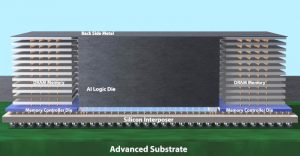Applied Materials improves die-to-wafer and wafer-to-wafer bonding

The development is improved software modelling and simulation for die-to-wafer hybrid bonding – which uses direct copper-to-copper interconnects to increase I/O density and shorten the wiring length between chiplets.
This will allow parameters such as material selection and packaging architecture to be evaluated and optimised prior to hardware development, and builds on the joint development agreement between Applied and BE Semiconductor Industries (Besi) in October last year, to develop equipment for die-based hybrid bonding.
“In a very short time, the Besi and Applied teams have made excellent progress working together at the hybrid bonding centre of excellence in Singapore,” said Besi CTO Ruurd Boomsma. “Our program with Applied Materials has greatly enhanced our combined understanding of the co-optimised equipment necessary.”
For wafer-to-wafer bonding, Applied announced a joint development agreement with EV Group (EVG), combining Applied’s semiconductor process knowledge of deposition, planarisation, implanting, metrology and inspection, with EVG’s expertise in wafer bonding, wafer pre-treatment and activation, as well as alignment and bond overlay metrology.
“Semiconductor innovation is increasingly being fuelled by 3D integration and engineered materials, which drives greater demand for wafer-to-wafer hybrid bonding. Optimising this process requires an in-depth understanding of integration issues both up and down the process chain,” said EVG business development manager Thomas Uhrmann. “Industry collaborations allow us to share data and learn from different areas of strength among process equipment companies.”
Applied also announced that its recent acquisition of Tango Systems has born fruit for panel-level processing, with it offering customers access to large-area (500 x 500mm, for example) materials technologies from its display group including deposition, e-beam testing, metrology and focused ion beam defect analysis.